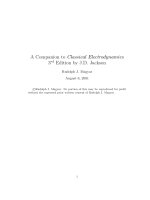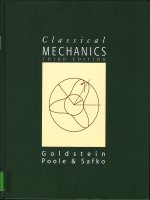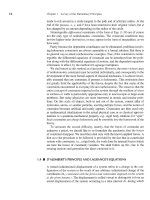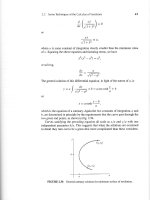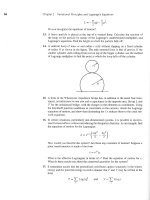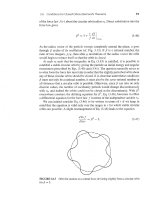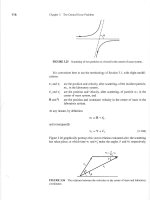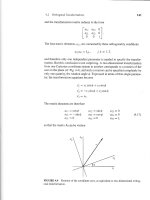- Trang chủ >>
- Khoa Học Tự Nhiên >>
- Vật lý
Companion to j d jacksons classical electrodynamics 3rd ed r magyar
Bạn đang xem bản rút gọn của tài liệu. Xem và tải ngay bản đầy đủ của tài liệu tại đây (1019.01 KB, 124 trang )
A Companion to Classical Electrodynamics
3rd Edition by J.D. Jackson
Rudolph J. Magyar
August 6, 2001
c Rudolph J. Magyar. No portion of this may be reproduced for profit
without the expressed prior written consent of Rudolph J. Magyar.
1
A lot of things can be said about Classical Electrodynamics, the third
edition, by David J. Jackson. It’s seemingly exhaustive, well researched, and
certainly popular. Then, there is a general consensus among teachers that
this book is the definitive graduate text on the subject. In my opinion, this
is quite unfortunate. The text often assumes familiarity with the material,
skips vital steps, and provides too few examples. It is simply not a good
introductory text. On the other hand, Jackson was very ambitious. Aside
from some notable omissions (such as conformal mapping methods), Jackson
exposes the reader to most of classical electro-magnetic theory. Even Thomas
Aquinas would be impressed! As a reference, Jackson’s book is great!
It is obvious that Jackson knows his stuff, and in no place is this more
apparent than in the problems which he asks at the end of each chapter.
Sometimes the problems are quite simple or routine, other times difficult, and
quite often there will be undaunting amounts of algebra required. Solving
these problems is a time consuming endevour for even the quickest reckoners
among us. I present this Companion to Jackson as a motivation to other
students. These problems can be done! And it doesn’t take Feynmann to do
them.
Hopefully, with the help of this guide, lots of paper, and your own wits;
you’ll be able to wrestle with the concepts that challenged the greatest minds
of the last century.
Before I begin, I will recommend several things which I found useful in
solving these problems.
• Buy Griffiths’ text, an Introduction to Electrodynamics. It’s well written and introduces the basic concepts well. This text is at a more basic
level than Jackson, and to be best prepared, you’ll have to find other
texts at Jackson’s level. But remember Rome wasn’t build in a day,
and you have to start somewhere.
• Obtain other texts on the level (or near to it) of Jackson. I recommend Vanderlinde’s Electromagnetism book or Eyges’ Electromagnetism book. Both provide helpful insights into what Jackson is talking
about. But even more usefully, different authors like to borrow each
others’ problems and examples. A problem in Jackson’s text might
be an example in one of these other texts. Or the problem might be
rephrased in the other text; the rephrased versions often provide insight
into what Jackson’s asking! After all half the skill in writing a hard
i
www.pdfgrip.com
physics problem is wording the problem vaguely enough so that no one
can figure out what your talking about.
• First try to solve the problem without even reading the text. More
often than not, you can solve the problem with just algebra or only a
superficial knowledge of the topic. It’s unfortunate, but a great deal of
physics problems tend to be just turning the crank. Do remember to
go back and actually read the text though. Solving physics problems
is meaningless if you don’t try to understand the basic science about
what is going on.
• If you are allowed, compare your results and methods with other students. This is helpful. People are quick to tear apart weak arguments
and thereby help you strengthen your own understanding of the physics.
Also, if you are like me, you are a king of stupid algebraic mistakes. If
ten people have one result, and you have another, there’s a good likelihood that you made an algebraic mistake. Find it. If it’s not there,
try to find what the other people could have done wrong. Maybe, you
are both correct!
• Check journal citations. When Jackson cites a journal, find the reference, and read it. Sometimes, the problem is solved in the reference,
but always, the references provide vital insight into the science behind
the equations.
A note about units, notation, and diction is in order. I prefer SI units
and will use these units whenever possible. However, in some cases, the use
of Jacksonian units is inevitable, and I will switch without warning, but of
course, I plan to maintain consistency within any particular problem. I will
set c = 1 and h
¯ = 1 when it makes life easier; hopefully, I will inform the
reader when this happens. I have tried, but failed, to be regular with my
symbols. In each case, the meaning of various letters should be obvious, or
else if I remember, I will define new symbols. I try to avoid the clumsy d3 x
symbols for volume elements and the d2 x symbols for area elements; instead,
ˆ The only
I use dV and dA. Also, I will use xˆ,ˆ
y , and zˆ instead of ˆi,ˆj, and k.
times I will use ijk’s will be for indices.
Please, feel free to contact me, , about any
typos or egregious errors. I’m sure there are quite a few.
ii
www.pdfgrip.com
Now, the fun begins...
iii
www.pdfgrip.com
Problem 1.1
Use Gauss’ theorem to prove the following:
a. Any excess charge placed on a conductor must lie entirely on
its surface.
In Jackson’s own words, “A conductor by definition contains charges capable
of moving freely under the action of applied electric fields”. That implies
that in the presence of electric fields, the charges in the conductor will be
accelerated. In a steady configuration, we should expect the charges not to
accelerate. For the charges to be non-accelerating, the electric field must
vanish everywhere inside the conductor, E = 0. When E = 0 everywhere
inside the conductor 1 , the divergence of E must vanish. By Gauss’s law,
we see that this also implies that the charge density inside the conductor
vanishes: 0 = ∇ · E = ǫρ0 .
b. A closed, hollow conductor shields its interior from fields due
to charges outside, but does not shield its exterior from the fields
due to charges placed inside it.
The charge density within the conductor is zero, but the charges must be
located somewhere! The only other place in on the surfaces. We use Gauss’s
law in its integral form to find the field outside the conductor.
E · dA =
1
ǫ0
qi
Where the sum is over all enclosed charges. Evidently, the field outside the
conductor depends on the surface charges and also those charges concealed
deep within the cavities of the conductor.
c. The electric field at the surface of a conductor is normal to the
surface and has a magnitude ǫσ0 , where σ is the charge density per
unit area on the surface.
We assume that the surface charge is static. Then, E at the surface of a conductor must be normal to the surface; otherwise, the tangential components
of the E-field would cause charges to flow on the surface, and that would
contradict the static condition we already assumed. Consider a small area.
∇ · EdV =
1
E · dA =
ρ
dV
ǫ0
excluding of course charge contained within any cavities
1
www.pdfgrip.com
But ρ = 0 everywhere except on the surface so ρ should more appropriately
be written σδ(f (x)). Where the function f (x) subtends the surface in question. The last integral can then be written ǫσ0 n
ˆ · dA. Our equation can be
rearranged.
E · dA =
σ
n
ˆ · dA →
ǫ0
And we conclude
E=
E−
σ
n
ˆ
ǫ0
2
www.pdfgrip.com
σ
n
ˆ · dA = 0
ǫ0
Problem 1.3
Using Dirac delta functions in the appropriate coordinates, express
the following charge distributions as three-dimensional charge densities ρ(x).
a. In spherical coordinates, a charge Q distributed over spherical shell of
radius, R.
The charge density is zero except on a thin shell when r equals R. The charge
density will be of the form, ρ ∝ δ(r − R). The delta function insures that
the charge density vanishes everywhere except when r = R, the radius of the
sphere. Integrating ρ over that shell, we should get Q for the total charge.
Aδ(r − R)dV = Q
A is some constant yet to be determined. Evaluate the integral and solve for
A.
Aδ(r − R)dV = Aδ(r − R)r 2 d(cos θ)dφdr = 4πR2 A = Q
So A =
Q
,
4πR2
and
Q
δ(r − R)
4πR2
b. In cylindrical coordinates, a charge λ per unit length uniformly distributed
over a cylindrical surface of radius b.
ρ(r) =
Aδ(r − b)dA = λ
Since we are concerned with only the charge density per unit length in the
axial direction, the integral is only over the plane perpendicular to the axis
of the cylinder. Evaluate the integral and solve for A.
Bδ(r − b)dA =
So B =
λ
,
2πb
Bδ(r − b)rdθdr = 2πbB = λ
and
λ
δ(r − b)
2πb
c. In cylindrical coordinates, a charge, Q, spread uniformly over a flat circular
disc of negligible thickness and radius, R.
ρ(r) =
AΘ(r − R)δ(z)dV = Q
3
www.pdfgrip.com
The Θ function of x vanishes when x is negative; when x is positive, Θ is
unity.
AΘ(R − r)δ(z)dV =
So A =
Q
,
πR2
AΘ(R − r)δ(z)rdθdzdr = πR2 A = Q
and
Q
Θ(R − r)δ(z)
πR2
d. The same as in part c, but using spherical coordinates.
ρ(r) =
AΘ(R − r)δ θ −
π
dV = Q
2
Evaluate the integral and solve for A.
AΘ(R − r)δ θ −
So A =
Q
,
2πR2
π
dV =
2
AΘ(R − r)δ θ −
π 2
r d(cos θ)dφdr
2
= 2πR2 A = Q
and
ρ(r) =
π
Q
Θ(R
−
r)δ
θ
−
2πR2
2
4
www.pdfgrip.com
Problem 1.5
The time-averaged potential of a neutral hydrogen atom is given
by
e−αr
1
Φ=q
1 + αr
r
2
where q is the magnitude of the electronic charge, and α−1 = a20 ,
a0 being the Bohr radius. Find the distribution of charge (both
continuous and discrete) that will give this potential and interpret
your result physically.
We are given the time average potential for the Hydrogen atom.
Φ=q
1
e−αr
1 + αr
r
2
Since this potential falls off faster than 1r , it is reasonable to suspect that
the total charge described by this potential is zero. If there were any excess
charge (+ of −) left over, it would have to produce a 1r contribution to the
potential.
Theoretically, we could just use Poisson’s equation to find the charge density.
ρ = −ǫ0 ∇2 Φ = −
ǫ0 d
2 dΦ
r
r 2 dr
dr
But life just couldn’t be that simple. We must be careful because of the
singular behavior at r = 0. Try Φ′ = − qr + Φ. This trick amounts to adding
a positive charge at the origin. We will have to subtract this positive charge
from our charge distribution later.
Φ′ = q
e−αr − 1
1
+ qαe−αr
r
2
which has no singularities. Plug into Poisson’s equation to get
ρ′ = −
ǫ0 d
dΦ
r2
2
r dr
dr
1
= − ǫ0 qα3 e−αr
2
The total charge density is then
1
ρ(r) = ρ′ (r) + qδ(r) = − ǫ0 qα3 e−αr + qδ(r)
2
Obviously, the second terms corresponds to the positive nucleus while the
first is the negative electron cloud.
5
www.pdfgrip.com
Problem 1.10
Prove the Mean Value Theorem: for charge free space the value of
the electrostatic potential at any point is equal to the average of
the potential over the surface of any sphere centered on that point.
The average value of the potential over the spherical surface is
¯=
Φ
1
4πR2
ΦdA
If you imagine the surface of the sphere as discretized, you can rewrite the
¯
integral as an infinite sum: a1 dA → area . Then, take the derivative of Φ
with respect to R.
¯
dΦ
dΦ
d
=
Φ=
dR
dR
dR
You can move the derivative right through the sum because derivatives are
linear operators. Convert the infinite sum back into an integral.
¯
dΦ
=
dR
dΦ
1
=
dR
4πR2
One of the recurring themes of electrostatics is
¯
dΦ
1
=
dR
4πR2
By Gauss’s law,
value theorem:
dΦ
dA
dR
dΦ
dR
1
dΦ
dA = −
dR
4πR2
= −En . Use it.
En dA = 0
En dA = 0 since qincluded = 0. And so we have the mean
¯
dΦ
¯ surf ace = Φcenter
=0→Φ
dR
q.e.d.
6
www.pdfgrip.com
Problem 1.12
Prove Green’s Reciprocation Theorem: If Φ is the potential due to
a volume charge density ρ within a volume V and a surface charge
density σ on the conducting surface S bounding the volume V ,
while Φ′ is the potential due to another charge distribution ρ′ and
σ ′ , then
ρΦ′ dV + σΦ′ dA = ρ′ ΦdV + σ ′ ΦdA
Green gave us a handy relationship which is useful here. Namely,
φ∇2 ψ − ψ∇2 φ dV ′ =
V
S
φ
∂ψ
∂φ
−ψ
dA
∂n
∂n
Let φ = Φ and ψ = Φ′ .
V
Φ∇2 Φ′ − Φ′ ∇2 Φ dV ′ =
S
Φ
∂Φ′
∂Φ
− Φ′
dA
∂n
∂n
Use Gauss’s law, ∇2 Φ = ǫρ0 , to replace the Laplacian’s on the left side of
the equal sign with charge densities. From problem 1.1, we know ∂Φ
= ǫσ0 .
∂n
Replace the derivatives on the right side by surface charge densities.
1
ǫ0
V
(Φρ′ − Φ′ ρ) d3 x′ =
1
ǫ0
S
[Φσ ′ − Φ′ σ] dA
With a tiny bit of rearrangement, we get Green’s reciprocity theorem:
ρΦ′ dV +
σΦ′ dA =
ρ′ ΦdV +
7
www.pdfgrip.com
σ ′ ΦdA
Problem 1.13
Two infinite grounded conducting planes are separated by a distance d. A point charge q is placed between the plans. Use the
reciprocation theorem to prove that the total induced charge on
one of the planes is equal to (−q) times the fractional perpendicular
distance of the point charge from the other plane.
Two infinite grounded parallel conducting planes are separated by a distance
d. A charge, q, is placed between the plates.
We will be using the Green’s reciprocity theorem
ρΦ′ dV +
σΦ′ dA =
ρ′ ΦdV +
σ ′ ΦdA
For the unprimed case, we have the situation at hand. ρ and σ vanish at
all points except at the two plates’ surfaces and at the point charge. The
potential at the two grounded plates vanishes.
We need to choose another situation with the same surfaces for which we
know the potential. The easiest thing that comes to mind is the parallel
plate capacitor. We take the first plate to be at x = 0 and the second at
x = d. The charge density vanishes everywhere except on the two plates.
The electrostatic potential is simple, Φ′ (x) = Φ0 xd which we know is true for
the parallel plate capacitor.
Plugging into Green’s reciprocity theorem, we have
q × Φ0
x
d
+ 0 + q ′ Φ0
d
d
8
www.pdfgrip.com
= (0) + (0)
With a little algebra, this becomes
x
q′ = − q
d
on plate two. By symmetry, we can read off the induced charge on the other
plate, q ′ = − d−x
q = −(1 − xd )q.
d
9
www.pdfgrip.com
Bonus Section: A Clever Ruse
This tricky little problem was on my qualifying exam, and I got it wrong.
The irony is that I was assigned a similar question as an undergrad. I got it
wrong back then, thought, “Whew, I’ll never have to deal with this again,”
and never looked at the solution. This was a most foolish move.
Calculate the force required to hold two hemispheres (radius R)
each with charge Q/2 together.
Think about a gaussian surface as wrapping paper which covers both hemispheres of the split orb. Now, pretend one of the hemispheres is not there.
Since Gauss’s law only cares about how much charge is enclosed, the radial
field caused by one hemisphere is
E=
1 1 Q
rˆ
2 4πǫ0 R2
Because of cylindrical symmetry, we expect the force driving the hemispheres
apart to be directed along the polar axis. The non polar components cancel,
so we need to consider only the polar projection of the electric field. The
assumption is that we can find the polar components of the electric field
by taking z part of the radial components. So we will find the northwardly
directed electric field created by the southern hemisphere and affecting the
northern hemisphere and integrate this over the infinitesimal charge elements
Q
of the northern hemisphere. Using dq = 4πR
2 dA, we have
Fz =
north
Q
1 Q
cos
θ
dA
4πǫ0 2R2
4πR2
Ez dq =
where θ is the angle the electric field makes with the z-axis.
Fz = −
1 Q2
2πR2
4πǫ0 8πR4
1
0
cos θd(cos θ) = −
Q2
32πǫ0 R2
The conclusions is that we have to push down on the upper hemisphere if
the bottom is fixed, and we want both shells to stay together.
10
www.pdfgrip.com
Problem 2.1
A point charge q is brought to a position a distance d away from an
infinite plane conductor held at zero potential. Using the method
of images, find:
a. the surface charge density induced on the plane, and plot it;
Jackson asks us to use the method of images to find the potential for a point
charge placed a distance, d, from a infinitely large zero potential conducting
x-z sheet located at y = 0.
Φ(r) =
1
q
4πǫ0
|ro − rq ′ |
+
1
q
4πǫ0 I
|ro − rI ′ |
The first term is the potential contribution from the actual charge q and the
second term is the contribution from the image charge qI . Let the coordinates
x, y, and z denote the position of the field in question, while the coordinates
x0 , y0 , and z0 denote the position of the actual charge. Choose a coordinate
system so that the real point charge is placed on the positive y-axis. x0
and y0 vanish in this coordinate system. Now, apply boundary conditions
Φ(y = 0) = 0.
Φ(y = 0) =
1
q
4πǫ0
x2 + z 2 + y02
+
1
q′
4πǫ0
(x − x′I )2 + y − yI′ 2 + (z − zI′ )2
=0
We can have Φ = 0 for all points on the x-z plane only if q ′ = −q, x′I = 0,
zI′ = 0, and yI′ = −y0 . Label y0 = d.
1
1
−
Φ(x, y, z) =
q
4πǫ0
x2 + (y − d)2 + z 2
1
x2
+ (y +
d)2
+
z2
To find the surface charge density induced on the sheet, we use the formula
from problem 1.1.
∂Φ
σ = ǫ0 En = −ǫ0
|y=0
∂y
σ=−
1
2d
q
q
3 = −
4πǫ0 (x2 + d2 + z 2 ) 2
4πǫ0 d2
11
www.pdfgrip.com
2
3
(1 + x2 /d2 + y 2 /d2 ) 2
0
surface charge density in units of q / ( 4 pi eps_0 d^2 )
-0.2
-0.4
-0.6
-0.8
-1
-1.2
-1.4
-1.6
-1.8
sigma(x^2+y^2)
-2
0
1
2
3
4
(x^2+y^2) / d^2
5
6
7
8
b. the force between the plane and the charge by using Coulumb’s
law for the force between the charge and its image;
The force between the charge and its image is given by Coulumb’s law.
F =
1
1 q2
qq ′
y
ˆ
=
−
yˆ
4πǫ0 |rq − rI ′ |2
4πǫ0 4d2
Where the effective distance between the charge and image is |rq ′ − rI ′ | = 2d.
The force is obviously attractive because of the minus sign.
σ2
over the
c. the total force acting on the plane by integrating 2ǫ
0
whole plane;
Now, we use the method Jackson suggests. First, we square our equation for
σ.
q2
4d2
σ2 =
16π 2 (x2 + d2 + z 2 )3
Jackson tell us that the force can be computed from the following integral:
F =
σ2
dA
2ǫ0
12
www.pdfgrip.com
So we do this integral.
F =
2π
∞
0
0
q2
rd2
dθdrˆ
y
32π 2 ǫ0 (r 2 + d2 )3
where r 2 = x2 + z 2 . Let u = r 2 + d2 and du = 2rdr.
F =
∞
−d2
q 2 1 d2
1 q2
duˆ
y
=
−
rˆ
16πǫ0 2 u3
4πǫ0 4d2
Which is the same as in part b.
d. The work necessary to remove the charge q from its position at
d to infinity;
W =
∞
F·r= −
d
1 q2
1 q2 ∞
q2
=
|
=
−
d
4πǫ0 4r 2
4πǫ0 4r
16πǫ0 d
The image charge is allowed to move in the calculation.
e. The potential energy between the charge q and its image. Compare to part d.
U =−
q2
1 1
q2
=
−
2 4πǫ0 |r − r ′ |
8πǫ0 d
Here we find the energy without moving the image charge so our result is
different from part d.
f. Find the answer to part d in electron volts for an electron originally one Angstrom from the surface.
1 q2
= 5.77 ×
Use the result from part d. Take d ≈ 1 Angstrom so W = 4πǫ
0 4d
−19
joules or 3.6 eV.
10
13
www.pdfgrip.com
Problem 2.2
Using the method of images, discuss the problem of a point charge
q inside a hollow, grounded, conducting sphere of inner radius a.
Find. . .
I botched this one up the first time I did it. Hopefully, this time things will
turn out better!
a. the potential inside the sphere
As implied by definition of conducting V = 0 on the surface. We must place
an image charge outside the sphere on the axis defined by the real charge q
and the center of the sphere. Use a Cartesian coordinate system and set the
x-axis to be the axis defined by the charge, its image, and the center of the
sphere.
1
q
+
Φ=
4πǫ0
(x − x1 )2 + y 2 + z 2
q′
(x − x′2 )2 + y 2 + z 2
The charge q is positioned at x1 and its image q ′ is at x′2 2 . For the real
a
charge outside the sphere and its image inside, Jackson finds qin = − xout
qout
a2
and xin = xout . We let xin = x1 and xout = x′2 , and the second equations
2
tells us: x′2 = xa1 . Let qin = q and qout = q ′ . Care must be taken because
the first equation depends on xo ut = x2 . q = − xa2 q ′ = − xa1 q ′ . So q ′ = − xa1 q.
Incidentally, even if I had no help from Jackson’s text, this is a good guess
because dimensionally it works. This image charge distribution does satisfy
the boundary conditions.
1
a
1
q
Φ(a) =
−
4πǫ0
x21 + a2 x1
1
2
( xa1 )2
+
a2
=0
A more rigorous determination in not necessary because this function is
unique. Therefore, for a real charge q placed within a conducting sphere
of radius a, we find the potential to be:
a
1
1
−
q
Φ(x, y, z) =
4πǫ0
(x − x1 )2 + y 2 + z 2 x1
2
1
(x −
a2 2
)
x1
+
y2
+
z2
I’ve been a little redundant with the subscript and the prime, but I felt clarity was
better than brevity at this point.
14
www.pdfgrip.com
where x1 < a for the charge inside the sphere and x1 = 0. The charge should
not be placed at the center of the sphere. I am sure that a limiting method
could reveal the potential for a charge at the center, but that is not necessary.
Use Gauss’s law to get
1 q
1 q
Φ=
−
4πǫ0 r 4πǫ0 a
b. the induced surface charge density
The surface charge density will simply be the same as calculated by Jackson
for the inverse problem. For a charge outside a conducting sphere, the surface
charge density is such.
a
1
q
σ=−
4πǫ0 x1 (1 +
a2
x21
1−
a2
x21
3
− 2 xa1 cos γ) 2
where γ is the angle between the x-axis and the area element. Jackson’s
, but our potential is functionally the
result comes from taking σ = −ǫ0 ∂Φ
∂n
same. Thus, our surface charge distribution will be the same.
1
a
σ=−
q
4πǫ0 x1 (1 +
a2
x21
1−
a2
x21
3
− 2 xa1 cos γ) 2
c. the magnitude and direction of the force acting on q.
The force acting on q can be obtained by Coulomb’s law.
F =
qq ′
1
a
1
=
q − q
′
2
4πǫ0 |r − r |
4πǫ0
x1
1
a2
x1
− x1
2
=−
1 2
ax1
q
2
4πǫ0 (a − x21 )2
d. Is there any change in the solution if the sphere is kept at fixed
potential Φ? Is the sphere has a total charge Q on its inner and
outer surfaces?
If the sphere is kept at a fixed potential Φ, we must add an image charge at
the origin so that the potential at R is Φ. If the sphere has a total charge
Q on its inner and outer surfaces, we figure out what image charge would
create a surface charge equal to Q and place this image at the origin.
15
www.pdfgrip.com
2.28
A closed volume is bounded by conducting surfaces that are the n
sides of a regular polyhedron (n = 4, 6, 8, 12, 20). The n surfaces are
at different potentials Φi , i = 1, 2, ..., n. Prove in the simplest way
you can that the potential at the center of the polyhedron is the
average of the potential on the n sides.
I will do a simple derivation. We have some crazy n-sided regular polyhedron.
That means that each side has the same area and each corner has the same
set of angles. If one side is at potential Φi but all the other sides are at zero
potential. The potential in the center of the polygon will be some value,
call it Φ′i . By symmetry, we could use this same approach for any side; A
potential Φi always produces another potential Φ′i at the center. Now, we
use linear superposition. Let all the sides be at Φi . Then, the potential at
the center is
n
Φ′i
Φcenter =
i=1
If all the Φi are equal, then so are all the Φ′i . Then, Φc = nΦ′i , and we
can solve for Φ′i = Φnc . If each surface is at some potential, Φi , then the
entire interior is at that potential, and Φi = Φc according to the mean value
theorem. Therefore, Φ′i = Φni is the contribution from each side.
For a set of arbitrary potentials for each side, we can use the principle of
linear superposition again.
1 n
Φc =
Φi
n i=1
q.e.d.
16
www.pdfgrip.com
Problem 3.3
A think, flat, circular, conducting disc of radius R is located in the
x-y plane with its center at the origin and is maintained at a fixed
potential Φ. With the information that the charge density of the
1
disc at fixed potential is proportional to (R2 − ρ2 )− 2 , where ρ is the
distance out from the center of the disk. . .
Note ρ is used where I usually use r ′ .
a. Find the potential for r > R.
For a charged ring at z = 0 on the r-φ plane, Jackson derived the following:
But
ρL
∞
L=0 r L+1 PL (0)PL (cos θ)
∞
rL
L=0 ρL+1 PL (0)PL (cos θ)
q
Φ(r, θ) =
q
PL (0) =
,r≥R
,r
0 , f or L odd
L
(L+1)!!
= f (L) , f or L even
(−1) 2 (L+1)L!!
We can replace L by 2ℓ because every other term vanishes.
1
Since σ ∝ (R2 − ρ2 )− 2 on the disk, the total charge on the disk is
R
Q=
0
√
2πκρ
dρ
R2 − ρ2
Let u = R2 − ρ2 , du = −2ρdρ, so
0
Q=−
R2
1
πκ
2
√ du = 2πκu 2 |R
0 = 2πκR
u
Q
And κ = 2πR
. Now, we solve for a disk made up of infinitely many infinitesimally small rings. Each contributes to the potential
ℓ
δΦ(r, θ) = σ
ρ2ℓ
f (2ℓ)P2ℓ (cos θ)dA, r ≥ R
2ℓ+1
ℓ=0 r
where f (2ℓ) = P2ℓ (0). And integrating over the disk gives the total potential.
Φ(r, θ) =
1
κ(R2 − ρ2 )− 2
= 2πκ
R
0
ℓ
ρ2ℓ
f (2ℓ)P2ℓ (cos θ)ρdρdφ
2ℓ+1
ℓ=0 r
1
(R2 − ρ2 )− 2
ρ2ℓ
f (2ℓ)P2ℓ (cos θ)ρdρ
r 2ℓ+1
17
www.pdfgrip.com
Consider the integral over ρ.
R
0
Let
ρ
R
√
ρ2ℓ+1
1
dρ =
2
2
R
R −ρ
R
0
ρ2ℓ+1
1−
ρ2
R2
dρ
= sin θ, dρ = R cos θdθ.
I1 =
π
2
1
R
0
R
(R)2ℓ+1 sin2ℓ+1 θ
2ℓ ℓ!
cos θdθ = R2ℓ+1
cos θ
(2ℓ + 1)!!
Using
π
2
sin2ℓ+1 θdθ =
0
So
2ℓ ℓ!
(2ℓ + 1)!!
R2ℓ+1
2ℓ ℓ!
f (2ℓ) 2ℓ+1 P2ℓ (cos θ)
(2ℓ + 1)!!
r
Φ = 2πκ
but we know f (2ℓ).
Φ=
4Q
R
(−1)ℓ
(2ℓ + 1)!!
R
2ℓ ℓ!
(2ℓ + 1)(2ℓ)!! (2ℓ + 1)!! r
2ℓ
R
P2ℓ (cos θ)
r
Since (2ℓ)!! = 2ℓ ℓ!,
Φ=
4Q
R
(−1)ℓ
R
1
2ℓ + 1 r
2ℓ
R
P2ℓ (cos θ) , r ≥ R
r
The potential on the disk at the origin is V.
V =
Using
√ dx
a2 −x2
R
2π
0
0
= sin−1
x
|a|
V =
And κ =
2Q
πR
=
V
.
π2
2V
Φ=
π
σρdρdφ =
2Q
2πρ
√ 2
dρ
πR |ρ| R − ρ2
,
2Q
x
2Qπ
2π sin−1
|R
0 =
πR
|R|
R
Then,
R
r
1
R
(−1)
2ℓ + 1 r
ℓ
18
www.pdfgrip.com
ℓ
P2ℓ (cos θ), r ≥ R
A similar integration can be carried out for r < R.
Φ=
2πQ 4Q
−
R
R
(−1)ℓ
2ℓ
1
r
2ℓ + 1 R
r
P2ℓ (cos θ) , r ≤ R
R
b. Find the potential for r < R.
I can’t figure out what I did here. I’ll get back to this.
c. What is the capacitance of the disc?
C = VQ , but from part a Q = 2VπR so
C=
2V R 1
π
V
=
19
www.pdfgrip.com
2R
π
Problem 3.9
A hollow right circular cylinder of radius b has its axis coincident
with the z axis and its ends at z = 0 and z = L. The potential on
the end faces is zero while the potential on the cylindrical surface
is given by Φ(φ, z). Using the appropriate separation of variables
in cylindrical coordinates, find a series solution for the potential
everywhere inside the cylinder.
V = 0 at z = 0, L. Because of cylindrical symmetry, we will try cylindrical
coordinates. Then, we have
∇2 Φ = 0 →
1 ∂
r ∂r
1 ∂2Φ ∂2Φ
1 ∂Φ
+ 2 2 + 2 =0
r ∂r
r ∂φ
∂z
Try Φ(r, φ, z) = R(r)Z(z)Q(φ). Separating the Laplace equation in cylindrical coordinates, we find three differential equations which must be satisfied.
∂2Z
− k2 Z = 0
2
∂z
has the solution
Z = A sin(kz) + B cos(kz)
The solution must satisfy boundary conditions that Φ = 0 at z = 0, L.
Therefore, B must vanish.
Z = A sin(kz)
where k = nπ
.
L
Similarly, we have for Q
∂2Q
− m2 Q = 0
2
∂φ
which has the solution
Q = C sin(mφ) + D cos(mφ)
m must be an integer for Q to be single valued.
The radial part must satisfy the frightening equation. Note the signs. This
is not the typical Bessel equations, but have no fear.
∂ 2 R 1 ∂R
m2
+
−
1
+
R=0
∂x2
x ∂x
x2
20
www.pdfgrip.com
where x = kr. The solutions are just modified Bessel functions.
R(x) = EIm (x) + F Km (x)
m must be an integer for R to be single valued. Im and Km are related to
other Bessel and Neumann functions via
Im (kr) = i−m Jm (ikr)
Km (kr) =
π m+1 (1)
i
Hm (ikr)
2
The potential is finite at r = 0 so
(1)
Hm
(0) = Jm (0) + iNm (0) = 0
But Km = 0 so F = 0.
We can now write Φ in a general form.
Φ = RZQ =
A sin
nπ
nπ
z (C sin(mφ) + D cos(mφ)) EIm
r
L
L
Let A and E be absorbed into C and D.
Φ=
∞
∞
nπ
nπ
z Im
r (Cmn sin(mφ) + Dmn cos(mφ))
L
L
sin
m=0 n=0
Now, we match boundary conditions. At r = b, Φ(φ, z) = V (φ, z). So
Φ(φ, z) =
sin
m,n
nπ
nπ
z Im
b (Cmn sin(mφ) + Dmn cos(mφ)) = V
L
L
′
The Im nπ
b are just a set of constants so we’ll absorb them into Cmn
and
L
′
′
′
Dmn for the time being. The coefficients, Cmn and Dmn , can be obtained via
Fourier analysis.
′
Cmn
=κ
′
Dmn
=κ
2π
2L
0
0
2π
2L
0
0
Φ(φ, z) sin
nπ
z sin (mφ) dφdz
L
Φ(φ, z) sin
nπ
z cos (mφ) dφdz
L
21
www.pdfgrip.com
